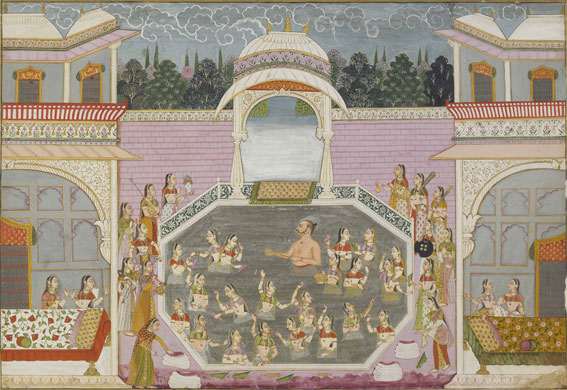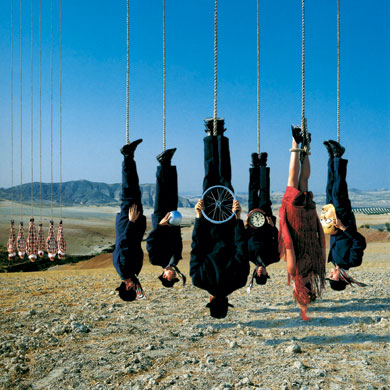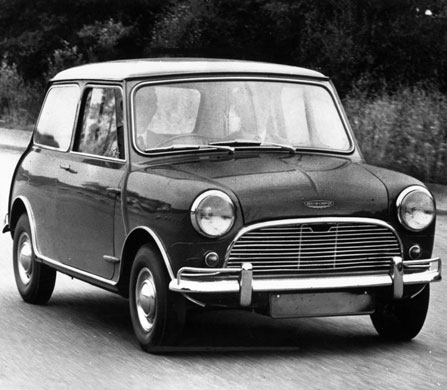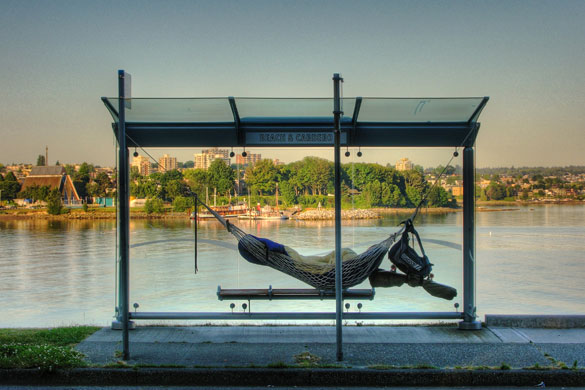If global development priorities are not reassessed to account for massive urban poverty, well over half of the 1.1 billion people projected to join the world’s population between now and 2030 may live in under-serviced slums, says a report published in January 2007. Additionally, while cities cover only 0.4 per cent of the Earth’s surface, they generate the bulk of the world’s carbon emissions, making cities key to alleviating the climate crisis, notes the report.
Source: The report by ‘State of the World 2007’ by the Washington-based Worldwatch Institute
May 31, 2009
A Decade in Photos
May 30, 2009
May 27, 2009
Math and the City
Reproduced from New York Times Blog: The Wild Side
May 19, 2009, 8:26 pm
By Steven Strogatz
May 19, 2009, 8:26 pm
By Steven Strogatz
As one of Olivia Judson’s biggest fans, I feel honored and a bit giddy to be filling in for her. But maybe I should confess up front that, unlike Olivia and the previous guest writers, I’m not a biologist, evolutionary or otherwise. In fact, I’m (gasp!) a mathematician.
One of the pleasures of looking at the world through mathematical eyes is that you can see certain patterns that would otherwise be hidden. This week’s column is about one such pattern. It’s a beautiful law of collective organization that links urban studies to zoology. It reveals Manhattan and a mouse to be variations on a single structural theme.
The mathematics of cities was launched in 1949 when George Zipf, a linguist working at Harvard, reported a striking regularity in the size distribution of cities. He noticed that if you tabulate the biggest cities in a given country and rank them according to their populations, the largest city is always about twice as big as the second largest, and three times as big as the third largest, and so on. In other words, the population of a city is, to a good approximation, inversely proportional to its rank. Why this should be true, no one knows.
Even more amazingly, Zipf’s law has apparently held for at least 100 years. Given the different social conditions from country to country, the different patterns of migration a century ago and many other variables that you’d think would make a difference, the generality of Zipf’s law is astonishing.
Keep in mind that this pattern emerged on its own. No city planner imposed it, and no citizens conspired to make it happen. Something is enforcing this invisible law, but we’re still in the dark about what that something might be.
Many inventive theorists working in disciplines ranging from economics to physics have taken a whack at explaining Zipf’s law, but no one has completely solved it. Paul Krugman, who has tackled the problem himself, wryly noted that “the usual complaint about economic theory is that our models are oversimplified — that they offer excessively neat views of complex, messy reality. [In the case of Zipf’s law] the reverse is true: we have complex, messy models, yet reality is startlingly neat and simple.”
After being stuck for a long time, the mathematics of cities has suddenly begun to take off again. Around 2006, scientists started discovering new mathematical laws about cities that are nearly as stunning as Zipf’s. But instead of focusing on the sizes of cities themselves, the new questions have to do with how city size affects other things we care about, like the amount of infrastructure needed to keep a city going.
For instance, if one city is 10 times as populous as another one, does it need 10 times as many gas stations? No. Bigger cities have more gas stations than smaller ones (of course), but not nearly in direct proportion to their size. The number of gas stations grows only in proportion to the 0.77 power of population. The crucial thing is that 0.77 is less than 1. This implies that the bigger a city is, the fewer gas stations it has per person. Put simply, bigger cities enjoy economies of scale. In this sense, bigger is greener.
The same pattern holds for other measures of infrastructure. Whether you measure miles of roadway or length of electrical cables, you find that all of these also decrease, per person, as city size increases. And all show an exponent between 0.7 and 0.9.
Now comes the spooky part. The same law is true for living things. That is, if you mentally replace cities by organisms and city size by body weight, the mathematical pattern remains the same.
For example, suppose you measure how many calories a mouse burns per day, compared to an elephant. Both are mammals, so at the cellular level you might expect they shouldn’t be too different. And indeed, when the cells of 10 different mammalian species were grown outside their host organisms, in a laboratory tissue culture, they all displayed the same metabolic rate. It was as if they didn’t know where they’d come from; they had no genetic memory of how big their donor was.
But now consider the elephant or the mouse as an intact animal, a functioning agglomeration of billions of cells. Then, on a pound for pound basis, the cells of an elephant consume far less energy than those of a mouse. The relevant law of metabolism, called Kleiber’s law, states that the metabolic needs of a mammal grow in proportion to its body weight raised to the 0.74 power.
This 0.74 power is uncannily close to the 0.77 observed for the law governing gas stations in cities. Coincidence? Maybe, but probably not. There are theoretical grounds to expect a power close to 3/4. Geoffrey West of the Santa Fe Institute and his colleagues Jim Brown and Brian Enquist have argued that a 3/4-power law is exactly what you’d expect if natural selection has evolved a transport system for conveying energy and nutrients as efficiently and rapidly as possible to all points of a three-dimensional body, using a fractal network built from a series of branching tubes — precisely the architecture seen in the circulatory system and the airways of the lung, and not too different from the roads and cables and pipes that keep a city alive.
These numerical coincidences seem to be telling us something profound. It appears that Aristotle’s metaphor of a city as a living thing is more than merely poetic. There may be deep laws of collective organization at work here, the same laws for aggregates of people and cells.
The numerology above would seem totally fortuitous if we hadn’t viewed cities and organisms through the lens of mathematics. By abstracting away nearly all the details involved in powering a mouse or a city, math exposes their underlying unity. In that way (and with apologies to Picasso), math is the lie that makes us realize the truth."
One of the pleasures of looking at the world through mathematical eyes is that you can see certain patterns that would otherwise be hidden. This week’s column is about one such pattern. It’s a beautiful law of collective organization that links urban studies to zoology. It reveals Manhattan and a mouse to be variations on a single structural theme.
The mathematics of cities was launched in 1949 when George Zipf, a linguist working at Harvard, reported a striking regularity in the size distribution of cities. He noticed that if you tabulate the biggest cities in a given country and rank them according to their populations, the largest city is always about twice as big as the second largest, and three times as big as the third largest, and so on. In other words, the population of a city is, to a good approximation, inversely proportional to its rank. Why this should be true, no one knows.
Even more amazingly, Zipf’s law has apparently held for at least 100 years. Given the different social conditions from country to country, the different patterns of migration a century ago and many other variables that you’d think would make a difference, the generality of Zipf’s law is astonishing.
Keep in mind that this pattern emerged on its own. No city planner imposed it, and no citizens conspired to make it happen. Something is enforcing this invisible law, but we’re still in the dark about what that something might be.
Many inventive theorists working in disciplines ranging from economics to physics have taken a whack at explaining Zipf’s law, but no one has completely solved it. Paul Krugman, who has tackled the problem himself, wryly noted that “the usual complaint about economic theory is that our models are oversimplified — that they offer excessively neat views of complex, messy reality. [In the case of Zipf’s law] the reverse is true: we have complex, messy models, yet reality is startlingly neat and simple.”
After being stuck for a long time, the mathematics of cities has suddenly begun to take off again. Around 2006, scientists started discovering new mathematical laws about cities that are nearly as stunning as Zipf’s. But instead of focusing on the sizes of cities themselves, the new questions have to do with how city size affects other things we care about, like the amount of infrastructure needed to keep a city going.
For instance, if one city is 10 times as populous as another one, does it need 10 times as many gas stations? No. Bigger cities have more gas stations than smaller ones (of course), but not nearly in direct proportion to their size. The number of gas stations grows only in proportion to the 0.77 power of population. The crucial thing is that 0.77 is less than 1. This implies that the bigger a city is, the fewer gas stations it has per person. Put simply, bigger cities enjoy economies of scale. In this sense, bigger is greener.
The same pattern holds for other measures of infrastructure. Whether you measure miles of roadway or length of electrical cables, you find that all of these also decrease, per person, as city size increases. And all show an exponent between 0.7 and 0.9.
Now comes the spooky part. The same law is true for living things. That is, if you mentally replace cities by organisms and city size by body weight, the mathematical pattern remains the same.
For example, suppose you measure how many calories a mouse burns per day, compared to an elephant. Both are mammals, so at the cellular level you might expect they shouldn’t be too different. And indeed, when the cells of 10 different mammalian species were grown outside their host organisms, in a laboratory tissue culture, they all displayed the same metabolic rate. It was as if they didn’t know where they’d come from; they had no genetic memory of how big their donor was.
But now consider the elephant or the mouse as an intact animal, a functioning agglomeration of billions of cells. Then, on a pound for pound basis, the cells of an elephant consume far less energy than those of a mouse. The relevant law of metabolism, called Kleiber’s law, states that the metabolic needs of a mammal grow in proportion to its body weight raised to the 0.74 power.
This 0.74 power is uncannily close to the 0.77 observed for the law governing gas stations in cities. Coincidence? Maybe, but probably not. There are theoretical grounds to expect a power close to 3/4. Geoffrey West of the Santa Fe Institute and his colleagues Jim Brown and Brian Enquist have argued that a 3/4-power law is exactly what you’d expect if natural selection has evolved a transport system for conveying energy and nutrients as efficiently and rapidly as possible to all points of a three-dimensional body, using a fractal network built from a series of branching tubes — precisely the architecture seen in the circulatory system and the airways of the lung, and not too different from the roads and cables and pipes that keep a city alive.
These numerical coincidences seem to be telling us something profound. It appears that Aristotle’s metaphor of a city as a living thing is more than merely poetic. There may be deep laws of collective organization at work here, the same laws for aggregates of people and cells.
The numerology above would seem totally fortuitous if we hadn’t viewed cities and organisms through the lens of mathematics. By abstracting away nearly all the details involved in powering a mouse or a city, math exposes their underlying unity. In that way (and with apologies to Picasso), math is the lie that makes us realize the truth."
May 26, 2009
Fashion and Art Collide in Hong Kong

Ym Yik/European Pressphoto Agency As a special commission for the “A Passion for Creation” exhibit currently on display at the Hong Kong Museum of Art, the artist Richard Prince has wrapped the museum building’s exterior with enlarged images from pulp-fiction novels, as an extension of his “Hong Kong After Dark” series.
Read more.May 25, 2009
May 24, 2009
Down with Innovation: Writes Rick Prynor in I.D. Magazine
In the 1980s, when I began to write about design, its appeal seemed fairly obvious. Things that had received the attention of good designers tended to look better than their more routine counterparts. This improvement was layered with all kinds of meanings tied up with the question of how and why something looked better. Nor could visual appeal be dissociated from the function of an object, graphic, or interior design. If the designer’s visual concerns got in the way of the design’s intended use, then this was naturally a problem. But the crucial point was still that the designed object was attractive and.... Read more.
Garden and Cosmos: Indian summer at the British Museum
Traditional Indian miniature paintings creatively flatten space and perspective to narrate complex human routines, stories and physical space in an idealized minimal paper space. The concept of history in Indian culture is nonlinear and atemporal. It is as heterogeneous as it is layered. These paintings depict space as time through nonlinear visual narration. -Viren

May 22, 2009
tetraktys on Vimeo
German multi-instrumentalist Christoph Haas (Stuttgart) converted harmonical spatial dimensions into sounds and rhythms.
May 21, 2009
May 19, 2009
The Modern Wing, Art Institute of Chicago, by Renzo Piano-
I admire Renzo Piano's work however, wonder at the same time: Is 21st century going to be about SuperModernism? -V.
Inside the Spiral - Interactive Feature
Interesting interactive panoramic view inside Frank Lloyd Wright's Guggenheim Museum (rotunda).
May 18, 2009
Photojournalism - Photography, Video and Visual Journalism - Lens Blog
NY Times has launched an interesting online journal/blog that chronicles photo essays and video features....
Slow Photography in an Instantaneous Age
May 17, 2009
May 16, 2009
Web site sparks creative ideas for city's vacant lots
Here is a story about a website that asks people to create their own images about different visions for infill in Baltimore on blocks with vacant row houses.

John Ruppert also submitted a waterfall. (Courtesy of John Ruppert)
Follow up to the post:: Web site sparks creative ideas for city's vacant lots
May 14, 2009
May 13, 2009
May 11, 2009
May 10, 2009
Leon Ferrari & Mira Schendel | Tangled Alphabets Selected Works
Leon Ferrari & Mira Schendel | Tangled Alphabet | Selected Works


The exhibition at MoMA, Tangled Alphabets redefines Typography as a spatial construct…. The works presented describe an architecture of ‘type’ - of the constructed ‘word’ that is tactile, hollow, and brittle and occupies space while defining it. Word as a ‘figure’ and not merely ‘texture’ or ‘ground’ repositions Gestalt in a whole different way. It’s the other that defines what is ‘between’. What separates is what connects and creates space between words, texts and the Type through ‘difference’.
The way Leon Ferrari and Mira Schendel employ ‘type’ to lay down geographies of space and culture and what lies in between……. -Viren
The exhibition at MoMA, Tangled Alphabets redefines Typography as a spatial construct…. The works presented describe an architecture of ‘type’ - of the constructed ‘word’ that is tactile, hollow, and brittle and occupies space while defining it. Word as a ‘figure’ and not merely ‘texture’ or ‘ground’ repositions Gestalt in a whole different way. It’s the other that defines what is ‘between’. What separates is what connects and creates space between words, texts and the Type through ‘difference’.
The way Leon Ferrari and Mira Schendel employ ‘type’ to lay down geographies of space and culture and what lies in between……. -Viren
The way Leon Ferrari and Mira Schendel employ ‘type’ to lay down geographies of space and culture and what lies in between……. -Viren
The exhibition at MoMA, Tangled Alphabets redefines Typography as a spatial construct…. The works presented describe an architecture of ‘type’ - of the constructed ‘word’ that is tactile, hollow, and brittle and occupies space while defining it. Word as a ‘figure’ and not merely ‘texture’ or ‘ground’ repositions Gestalt in a whole different way. It’s the other that defines what is ‘between’. What separates is what connects and creates space between words, texts and the Type through ‘difference’.
The way Leon Ferrari and Mira Schendel employ ‘type’ to lay down geographies of space and culture and what lies in between……. -Viren
Tangled Alphabets | Leon Ferrari & Mira Schendel
Leon Ferrari & Mira Schendel | Tangled Alphabets Timeline
The exhibition at MoMA, Tangled Alphabets redefines Typography as a spatial construct…. The works presented describe an architecture of ‘type’ - of the constructed ‘word’ that is tactile, hollow, and brittle and occupies space while defining it. Word as a ‘figure’ and not merely ‘texture’ or ‘ground’ repositions Gestalt in a whole different way. It’s the other that defines what is ‘between’. What separates is what connects and creates space between words, texts and the Type through ‘difference’.
The way Leon Ferrari and Mira Schendel employ ‘type’ to lay down geographies of space and culture and what lies in between……. -Viren
The exhibition at MoMA, Tangled Alphabets redefines Typography as a spatial construct…. The works presented describe an architecture of ‘type’ - of the constructed ‘word’ that is tactile, hollow, and brittle and occupies space while defining it. Word as a ‘figure’ and not merely ‘texture’ or ‘ground’ repositions Gestalt in a whole different way. It’s the other that defines what is ‘between’. What separates is what connects and creates space between words, texts and the Type through ‘difference’.
The way Leon Ferrari and Mira Schendel employ ‘type’ to lay down geographies of space and culture and what lies in between……. -Viren
The way Leon Ferrari and Mira Schendel employ ‘type’ to lay down geographies of space and culture and what lies in between……. -Viren
The exhibition at MoMA, Tangled Alphabets redefines Typography as a spatial construct…. The works presented describe an architecture of ‘type’ - of the constructed ‘word’ that is tactile, hollow, and brittle and occupies space while defining it. Word as a ‘figure’ and not merely ‘texture’ or ‘ground’ repositions Gestalt in a whole different way. It’s the other that defines what is ‘between’. What separates is what connects and creates space between words, texts and the Type through ‘difference’.
The way Leon Ferrari and Mira Schendel employ ‘type’ to lay down geographies of space and culture and what lies in between……. -Viren
 | |
May 9, 2009
The Harlem Miracle - NYTimes.com
Here is a heartening piece about Harlem's Charter Schools Program, and what small steps can do if thought out in big ways.
"The fight against poverty produces great programs but disappointing results. You go visit an inner-city school, job-training program or community youth center and you meet incredible people doing wonderful things. Then you look at the results from the serious evaluations and you find that these inspiring places are only producing incremental gains."
"The fight against poverty produces great programs but disappointing results. You go visit an inner-city school, job-training program or community youth center and you meet incredible people doing wonderful things. Then you look at the results from the serious evaluations and you find that these inspiring places are only producing incremental gains."
May 8, 2009
YouTube - You and Your Browser
Google Chrome Commercial to air on TV! Sounds like an oxymoron? It ain't!
May 5, 2009
May 2, 2009
Museums - In Berlin, Teaching Germany’s Jewish History
Say it as it is. Unpretentious criticism of architecture is so rare! Here is an exception - It draws attention to 'lost space' of critical debate lacking in contemporary writing about architecture. As all serious architects, writers and those who still believe that architecture has a place in the process of cultural production know how architecture has become increasingly about itself and lost its 'reflexive' nature.

Related Article
Subscribe to:
Posts (Atom)

 Source: Ny Times
Source: Ny Times































